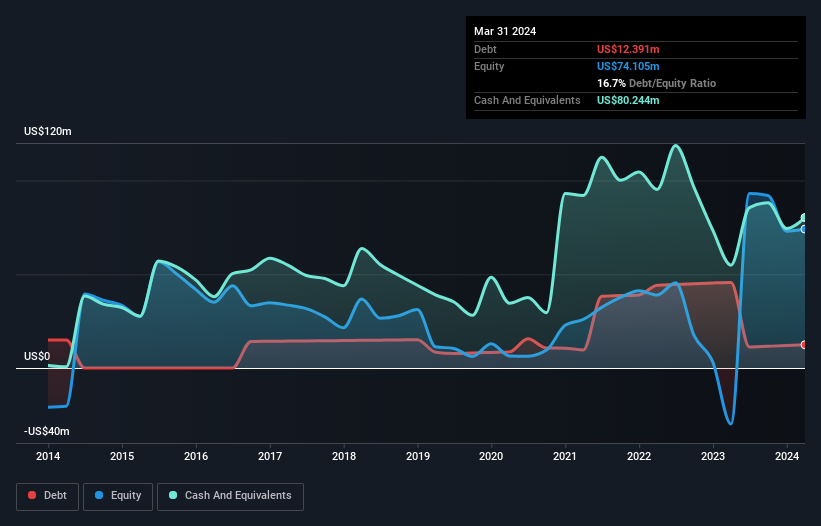Legendary fund manager Li Lu (who Charlie Munger backed) once said, 'The biggest investment risk is not the volatility of prices, but whether you will suffer a permanent loss of capital.' It's only natural to consider a company's balance sheet when you examine how risky it is, since debt is often involved when a business collapses. Importantly, SCYNEXIS, Inc. (NASDAQ:SCYX) does carry debt. But the real question is whether this debt is making the company risky.
What Risk Does Debt Bring?
Debt is a tool to help businesses grow, but if a business is incapable of paying off its lenders, then it exists at their mercy. Ultimately, if the company can't fulfill its legal obligations to repay debt, shareholders could walk away with nothing. However, a more common (but still painful) scenario is that it has to raise new equity capital at a low price, thus permanently diluting shareholders. Having said that, the most common situation is where a company manages its debt reasonably well - and to its own advantage. When we think about a company's use of debt, we first look at cash and debt together.
See our latest analysis for SCYNEXIS
How Much Debt Does SCYNEXIS Carry?
You can click the graphic below for the historical numbers, but it shows that SCYNEXIS had US$12.4m of debt in March 2024, down from US$45.6m, one year before. But on the other hand it also has US$80.2m in cash, leading to a US$67.9m net cash position.

A Look At SCYNEXIS' Liabilities
The latest balance sheet data shows that SCYNEXIS had liabilities of US$27.3m due within a year, and liabilities of US$16.8m falling due after that. On the other hand, it had cash of US$80.2m and US$19.5m worth of receivables due within a year. So it can boast US$55.6m more liquid assets than total liabilities.
This excess liquidity is a great indication that SCYNEXIS' balance sheet is almost as strong as Fort Knox. With this in mind one could posit that its balance sheet means the company is able to handle some adversity. Succinctly put, SCYNEXIS boasts net cash, so it's fair to say it does not have a heavy debt load!
Although SCYNEXIS made a loss at the EBIT level, last year, it was also good to see that it generated US$74m in EBIT over the last twelve months. The balance sheet is clearly the area to focus on when you are analysing debt. But ultimately the future profitability of the business will decide if SCYNEXIS can strengthen its balance sheet over time. So if you're focused on the future you can check out this free report showing analyst profit forecasts.
Finally, a business needs free cash flow to pay off debt; accounting profits just don't cut it. While SCYNEXIS has net cash on its balance sheet, it's still worth taking a look at its ability to convert earnings before interest and tax (EBIT) to free cash flow, to help us understand how quickly it is building (or eroding) that cash balance. Over the last year, SCYNEXIS actually produced more free cash flow than EBIT. That sort of strong cash conversion gets us as excited as the crowd when the beat drops at a Daft Punk concert.
Summing Up
While it is always sensible to investigate a company's debt, in this case SCYNEXIS has US$67.9m in net cash and a decent-looking balance sheet. The cherry on top was that in converted 102% of that EBIT to free cash flow, bringing in US$75m. So we don't think SCYNEXIS's use of debt is risky. When analysing debt levels, the balance sheet is the obvious place to start. However, not all investment risk resides within the balance sheet - far from it. For example SCYNEXIS has 4 warning signs (and 1 which is concerning) we think you should know about.
If, after all that, you're more interested in a fast growing company with a rock-solid balance sheet, then check out our list of net cash growth stocks without delay.
New: Manage All Your Stock Portfolios in One Place
We've created the ultimate portfolio companion for stock investors, and it's free.
• Connect an unlimited number of Portfolios and see your total in one currency
• Be alerted to new Warning Signs or Risks via email or mobile
• Track the Fair Value of your stocks
Have feedback on this article? Concerned about the content? Get in touch with us directly. Alternatively, email editorial-team (at) simplywallst.com.
This article by Simply Wall St is general in nature. We provide commentary based on historical data and analyst forecasts only using an unbiased methodology and our articles are not intended to be financial advice. It does not constitute a recommendation to buy or sell any stock, and does not take account of your objectives, or your financial situation. We aim to bring you long-term focused analysis driven by fundamental data. Note that our analysis may not factor in the latest price-sensitive company announcements or qualitative material. Simply Wall St has no position in any stocks mentioned.
About NasdaqGM:SCYX
SCYNEXIS
A biotechnology company, develops medicines to overcome and prevent difficult-to-treat and drug-resistant infections in the United States.
Medium-low risk with excellent balance sheet.
Market Insights
Community Narratives



